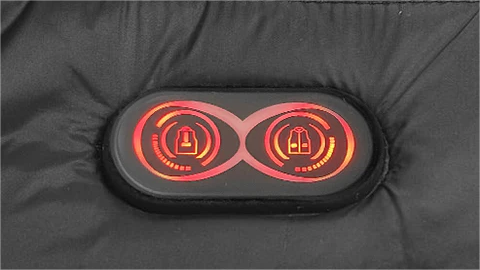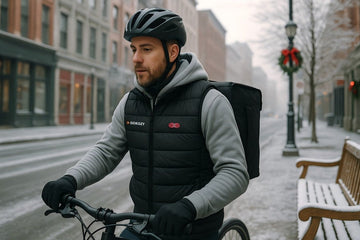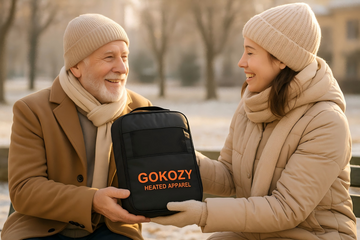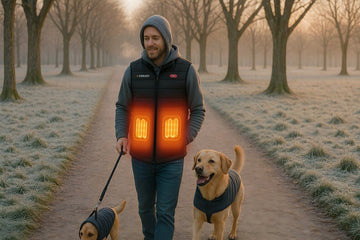Heated vests are becoming more popular as a warm and comfortable option to bulky winter clothing. They're great for outdoor adventures, working in cold conditions, or just staying warm during your daily activities. But with so many choices available, finding the right one can be tricky. This guide will help you pick the perfect heated vest based on your needs.
1. Identify Your Use Case
The first step in choosing a heated vest is understanding how and where you plan to use it. Different environments and activities require different types of vests:
Outdoor Activities
If you're into hiking, camping, or skiing, you'll need a vest that can handle varying weather conditions and provide consistent warmth.
Workwear
For those working in construction or other cold environments, a more rugged, durable vest that can withstand tough conditions is ideal.
Everyday Use

If you need a vest for daily wear, whether commuting or running errands, it’s essential to choose something lightweight and comfortable that fits well under regular clothing. The GOKOZY heated fleece vest is an excellent option for everyday use, offering both warmth and versatility. Its slim design ensures it layers comfortably under your jacket or coat, while the dual-control heating zones allow you to adjust the warmth to your liking, making it perfect for daily activities in varying temperatures.
2. Choose the Right Voltage
Heated vests come with different power requirements, typically 5V, 7.4V, or 12V:
- 5V Vests: These are best for everyday use. They are usually powered by standard USB power banks, making them easy to charge and use.
- 7.4V Vests: A good middle-ground option, 7.4V vests provide more warmth and are suitable for most outdoor activities.
- 12V Vests: These are the most powerful and are designed for extreme cold. They are often used by professionals who need reliable warmth in harsh winter conditions.
3. Consider Battery Capacity
The battery capacity directly affects how long your heated vest will keep you warm. Here’s how to choose based on your needs:
- High Capacity (20,000mAh or more): Ideal for long outdoor activities or extended work shifts in the cold.
- Standard Capacity (10,000mAh): Good for a balance between heating duration and vest weight, suitable for most users.
- Low Capacity (5,000mAh): These are lighter and perfect for short outings or as a backup battery.
4. Select the Right Fabric
The fabric of your heated vest can make a big difference in comfort and functionality:
- Outdoor Use: Opt for windproof and waterproof materials to protect against the elements.
- Workwear: Look for durable, abrasion-resistant fabrics that can handle tough environments.
- Everyday Use: Choose soft, breathable materials that are easy to clean and comfortable for all-day wear.
5. Understand Heating System Materials
Heated vests use different materials to generate warmth:
- Composite Fiber: Lightweight and flexible, suitable for general use but may not be as durable.
- Carbon Fiber: Known for its durability and resistance to frequent washing, making it ideal for regular use.
-
Graphene: Offers excellent heat distribution and efficiency, though it’s often more expensive.

6. Decide on Insulation Layer
Whether your vest has an insulation layer can impact its performance in different environments:
- With Insulation: Best for very cold or outdoor environments, as it helps retain heat.
- Without Insulation: These vests are lighter and more comfortable for indoor or moderate climates.
7. Check for Zone Control Features

Zone control is a valuable feature in heated vests, allowing you to customize the warmth according to your needs. Dual or Multi-Zone Control lets you adjust the heat in different parts of the vest independently, offering more precise temperature management.
All GOKOZY Heated Vests come with dual control, enabling you to set different temperatures for the front and back zones. This feature ensures you can achieve the perfect balance of warmth, no matter the conditions.
8. Evaluate the Number of Heating Zones

When choosing a heated vest, more heating zones don’t always mean better warmth. The battery’s power, usually limited to 10W-20W, is spread thinner across more zones, potentially reducing the heat each area receives, especially in cold environments.
3-5 Zones: Focuses heat on key areas like the chest and back, providing concentrated warmth, ideal for very cold conditions.
6-9 Zones:Covers more areas like the neck and shoulders, but the heat may be less intense as it's spread across more zones.
10+ Zones: Can dilute the overall heating effectiveness, as too many zones might reduce the warmth each receives.
9. Battery Inclusion Options
With Battery: Vests that come with a battery included, typically more convenient but may be more expensive.
Without Battery: Often seen with 5V vests, allowing users to use their own power banks, which can be cost-effective if you already own compatible batteries.
10. Additional Features to Consider
Finally, consider any extra features that might enhance your experience:
- App Control: Some vests can be controlled via a smartphone app, allowing you to adjust settings remotely.
- Safety Features: Look for vests with auto-shutoff and overheat protection to ensure safe use.
- Ease of Use: Make sure the vest is easy to adjust, charge, and clean.
Conclusion
Choosing the right heated vest involves considering a variety of factors, from your specific use case to the vest's technical specifications. By understanding your needs and how different features affect performance, you can select a heated vest that will keep you warm and comfortable, whether you’re braving the outdoors, working in cold conditions, or just staying cozy during your daily routine.
FAQs
What is the best voltage for a heated vest?
It depends on your needs. 5V is good for everyday use, 7.4V for outdoor activities, and 12V for extreme cold.
How long does the battery last on a full charge?
Battery life varies by capacity but typically ranges from 4 to 10 hours.
Can I wash my heated vest in a washing machine?
Most vests are machine washable, but always follow the manufacturer’s care instructions.
Is a higher number of heating zones always better?
Not necessarily. More zones can dilute the heat if the power isn’t sufficient.
Do all heated vests come with a battery?
No, some vests do not include a battery, allowing you to use your own power bank.






